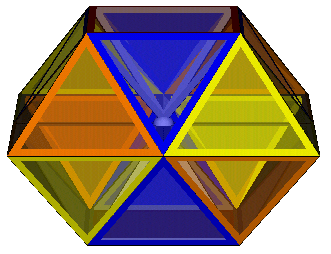
Elementary Honeycombs
It has long been recognised that space can be filled with uniform polyhedra. A 'uniform honeycomb' is a figure defined as a tiling of 3space where "all of whose cells are uniform polyhedra and whose vertices are transitive on its symmetry group, and which covers three-space exactly once" [1]. There are 28 known figures, these are listed by Banko Gr°nbaum in "Uniform tilings of 3-space" [2]. Images and models of all 28 uniform honeycombs are presented by Alex Doskey on his page at http://www.doskey.com/polyhedra/UniformHoneycombs.html. [3]
Inspired by Alex's work, I have begun to explore a similar set of honeycombs, which I term 'elementary honeycombs'. In place of the requirement that all cells are uniform polyhedra, I require each cell to be a regularly faced, elementary polyhedron: one which "cannot be separated by a plane into two smaller regularly-faced polyhedra" [4]. Candidates for such polyhedra include certain platonic and archimedean polyhedra and some of the Johnson Solids [5]. The restrictions that vertices are transitive on the symmetry group, and single coverage of three-space are unchanged.
Of the 28 uniform honeycombs, eleven are formed by taking a regular tessellation of the plane and replacing the polygons with prisms. These are then stacked to fill space. A further example is formed by gyrating alternative rows of triangular prisms, this is shown on Alex Doskey's page as number 23. Two more examples are formed by alternating rows of cubes and triangular prisms, these are shown on Alex Doskey's page as numbers 24 and 25. The two honeycombs differ as the alternate rows of triangular prisms can be set either parallel or perpendicular to each other.
In addition to the fourteen 'regular elementary honeycombs', I have discovered a further 13 examples. These are described in some detail below.
My notation for the elementary honeycombs is taken from the cells surrounding a vertex. The notation xA1-yA2 means that there are x examples of polyhedron A1 and y examples of polyhedron A2 around each vertex. The notation for individual cells is as follows:
Pn - n-gonal prism, including P3=triangular
prism and P4=cube.
Qn - n-gonal cupola, Q3=triangular cupola*,
Q4=square cupola.
Sn - n-gonal anti-prism, S3=octahedron*
(*=not elementary)
T - tetrahedron
Yn - n-gonal pyramid, Y4=square pyramid.
Where a non-regular polyhedron is used in the formation of a honeycomb, a restriction has to apply to preserve vertex transitivity. If the polyhedron has type A vertices and type B vertices in the ratio a:b, then the number of type A vertices and the number of type B vertices at any one vertex of the honeycomb must also be in the ratio a:b. This means that the number of such polyhedra at each vertex of the honeycomb must be a multiple of (a+b). For example, the square pyramid has one apex of the form (34) and four base vertices of the form (4°32). Any honeycomb containing square pyramids must have a multiple of 5 at each vertex, of which 1/5 must have apex vertices at the honeycomb vertex in question. The notation for such honeycombs (such as 10Y4-8T) is therefore sufficient to define the number of each type of cell vertex at the honeycomb vertex.
The following elementary honeycombs are presented in sequence
Page 1:
Honeycombs derived from the octahedral/tetrahedral honeycomb part 1
10Y4-8T-n
5Y4-4T-4P4
5Y4-4T-6P3-sq-ortho
5Y4-4T-6P3-sq-gyro
Page
2: Honeycombs
derived from the octahedral/tetrahedral honeycomb part 2
10Y4-8T-ortho
10Y4-8T-meta
10Y4-8T-para
Page 3: Honeycombs
derived from the octahedral/tetrahedral honeycomb part 3
5Y4-4T-6P3-tri-n
5Y4-4T-6P3-tri-ortho
5Y4-4T-6P3-tri-meta
5Y4-4T-6P3-tri-para
Page 4: Honeycombs
derived from the runcinated alternated cubic honeycomb
3Q4-T-2P8-P4
6Q4-2T
Page
5: Honeycombs derived from the rectified cubic honeycomb (not elementary)
6Q3-2S3-gyro
6Q3-2S3-ortho
3Q3-S3-2P6-2P3-gyro
3Q3-S3-2P6-2P3-ortho
Dr Richard Klitzing has kindly provided incidence matrices for all of the above honeycombs. These can be found here, or by clicking on the text 'Incidence Matrix' by each honeycomb.
References
[1] Olshevsky G. (as quoted by Alex Doskey) - see [3].
[2] Gr°nbaum B. (1994) Uniform tilings of 3-space," Geombinatorics 4, 49-56
[3] Doskey A. [Online], available from http://www.doskey.com/polyhedra/UniformHoneycombs.html
[4] Cromwell P. (1997) Polyhedra, Cambridge University Press
[5] Johnson N.W. (1966) Convex Solids with Regular Faces, Canadian Journal of Mathematics, 18, 169-200